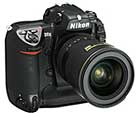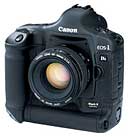PhotoHistory 2004
Chronological history of photography in Japan in 2004 (Heisei 16)
Researched and compiled by Philbert Ono
Jan. 7-25 - The Nara City Museum of Art holds a free exhibition showing about 100 news photos (taken by the Fukui Shimbunsha newspaper) of the five Japanese who were abducted by North Korea in 1978 and returned to Japan for the first time in Oct. 2002. The photos center on Yasushi Chimura and his wife who attended the exhibition's opening ceremonies.
Feb. - Starting with their film and digital cameras announced in Feb. 2004, Konica Minolta abolishes the "Minolta" camera brand in favor of "Konica Minolta". They were originally going to keep the "Minolta" camera brand, but parent company Konica Minolta Holdings became strongly in favor of unifying the brand name for all product lines to "Konica Minolta."
Feb. 29 - Polaroid Gallery in Tokyo closes after being in operation since 1977.
Mar. 19 - Nikon markets the long-awaited, entry-level Nikon D70, its lowest-priced digital SLR camera ever. Featuring a 6.1-megapixel CCD sensor, the camera body retails for 150,000 yen while the lens kit (18-70mm DX lens) is priced at 206,000 yen (excluding tax). After six months on the market, the Canon Kiss Digital (300D) finally has a rival.
April 1 - A new company called Konica Minolta Photo Imaging is formed upon the merging of Konica Minolta Camera (which was in charge of camera manufacturing and sales) and Konica Minolta Photo Imaging which was in charge of film manufacturing and sales.
April 7 - Soichiro Koriyama, a 32-year-old freelance photojournalist, is taken hostage in Iraq along with Nahoko Takato, a volunteer aid worker, and Noriaki Imai, a recent high school graduate. The three were later released unharmed on April 15 and returned to Japan three days later. The captors were members of the Saraya al-Mujahideen (Mujahideen Brigades).
May 15 - During the morning procession of the annual Aoi (Hollyhock) Festival in Kyoto, a camera flash apparently spooked two of the horses in the parade and one of the horses ran amok onto the street where it collided with a passenger car whose windshield was smashed. The horse kept galloping for over a kilometer even with a leg injured by the car. It was finally caught by parade staff 10 min. later. No one was injured.
June 9 - At the G8 Summit held in Sea Island, Georgia USA, Prime Minister Jun'ichiro Koizumi manages to position himself near the center for the official group portrait of the eight world leaders from the United States, Canada, Britain, Germany, Italy, France, Japan and Russia. It has been 21 years since a Japanese prime minister (since Yasuhiro Nakasone) stood toward the center for the portrait. At previous summits, Koizumi was always positioned well off-center near the edge.
June 18 - The Fuji Photo Salon photo gallery opens in Hiroshima.
July - In Arles, France, the annual and famous Rencontres d'Arles photo festival is held and the exhibitions included Japanese photographers Rinko Kawauchi, Osamu Kanemura, Taiji Matsue, and the late Ihei Kimura.
Kimura's photos of Paris in the 1950s proved to be so popular that they were also exhibited at the Maison Européenne de la Photographie museum in Paris from Sept. to Oct. 2004. Some of the photos also appeared in Le Monde 2 magazine's Sept. 11 issue and Bazaar's Aug. issue.
July 21 - At its Tokyo showroom, Mazda Motors Corp. shows off a giant photo book featuring the company's Verisa compact car. The 16-page book measures 3.07 meters high and 3.42 meters wide and weighs 352 kg. Claiming it to be the world's largest photo book, Mazda plans to apply for a listing in the Guinness Book of World Records.
Aug. 13-29 - At the Athens Summer Olympics, more than 70% of registered professional photographers shot with Canon EOS cameras.
Aug. 20 - Canon announces its new EOS 20D digital SLR camera to be marketed in late Sept. Succeeding the EOS 10D, it features an 8.20-megapixel CMOS sensor, fast startup time of 0.3 sec., and compatibility with EF-S lenses.
Sep. 15 - The Fuji Photo Salon photo gallery opens in Sendai, Miyagi Pref.
 Sept. 16 - Nikon makes twin product announcements for two top-of-the-line SLR cameras. One was for its new flagship D-SLR, the D2X (pictured) to replace the D1X. The D2X features a 12.4-megapixel CMOS sensor (not full-frame) made by Sony. It will go on sale in Jan. 2005 (later delayed to Feb.) for 600,000 yen retail. The second announcement was for the Nikon F6 film SLR replacing the F5, reflecting Nikon's committment to film. The F6 will go on sale on Oct. 22 for 300,000 yen retail.
Sept. 16 - Nikon makes twin product announcements for two top-of-the-line SLR cameras. One was for its new flagship D-SLR, the D2X (pictured) to replace the D1X. The D2X features a 12.4-megapixel CMOS sensor (not full-frame) made by Sony. It will go on sale in Jan. 2005 (later delayed to Feb.) for 600,000 yen retail. The second announcement was for the Nikon F6 film SLR replacing the F5, reflecting Nikon's committment to film. The F6 will go on sale on Oct. 22 for 300,000 yen retail.
 Sept. 22 - Only days after Nikon's exciting D2X announcement, Canon stuns Nikon by announcing its new, top-of-the-line EOS-1Ds Mark II digital SLR (pictured) boasting 16.7 megapixels on a full-frame CMOS sensor. The camera will go on sale in late Nov., two months before Nikon sells the D2X. Canon even contends that the camera is a viable replacement for medium-format digital cameras. Nikon is now seen as well behind Canon in the D-SLR competition.
Sept. 22 - Only days after Nikon's exciting D2X announcement, Canon stuns Nikon by announcing its new, top-of-the-line EOS-1Ds Mark II digital SLR (pictured) boasting 16.7 megapixels on a full-frame CMOS sensor. The camera will go on sale in late Nov., two months before Nikon sells the D2X. Canon even contends that the camera is a viable replacement for medium-format digital cameras. Nikon is now seen as well behind Canon in the D-SLR competition.
Late Sept. - Canon starts selling the EOS 20D along with the new EF-S 18-55mm USM lens. The camera soon runs into firmware problems and it takes Canon at least two firmware updates to fix the problem.
In the fall, TOMATSU Shomei holds a large exhibition titled "Skin of the Nation" at the Japan Society's main gallery in New York City. The show runs until Jan. 2, 2005. Due to a heart condition, Tomatsu is unable to fly to New York.
Oct. 29 - French publisher Flammarion puts out a large book called Japan: A Self Portrait (ISBN: 2080304631). It features B/W works produced during the post-war period of 1945 to 1964 by well-known Japanese photographers Ken Domon, Hiroshi Hamaya, Tadahiko Hayashi, Eikoh Hosoe, Yasuhiro Ishimoto, Kikuji Kawada, Ihee Kimura, Shigeichi Nagano, Ikko Narahara, Takeyoshi Tanuma, and Shomei Tomatsu. French and Japanese versions are also published. (Philbert Ono was also one of the consultants for the book.)
Dec. - The Tokyo Photographic Culture Centre (Tokyo Shashin Bunka-kan), a large gallery in Akasaka, Tokyo, closes its doors at the end of 2004.
Dec. - Longtime photo supply wholesaler Omiya Photo Supply Co. disbands due to the slumping demand for film-related supplies. Their sales activities are taken over by Fuji Photo Film.
Next: PhotoHistory 2005